Scientific name Petromyzontiformes | ||
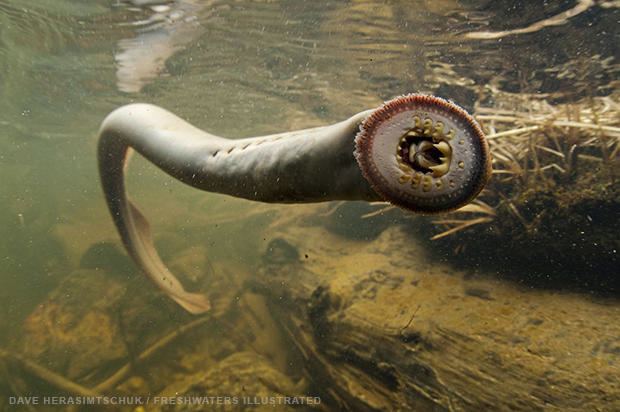 | ||
Similar Eel, Ascidians, Sturgeon, Batoids, Trout | ||
silent invaders sea lamprey 2013
Lampreys (sometimes also called, inaccurately, lamprey eels) are any jawless fish of the order Petromyzontiformes, placed in the superclass Cyclostomata. The adult lamprey may be characterized by a toothed, funnel-like sucking mouth. The common name "lamprey" is probably derived from Latin Lampetra, which may mean "stone licker" (lambere "to lick" + petra "stone"), though the etymology is uncertain.
Contents
- silent invaders sea lamprey 2013
- Sea lamprey panic response
- Lifecycle
- Use in research
- Distribution
- Taxonomy and systematics
- Fossil record
- As pests
- As food
- In folklore
- In literature
- List of species
- References

Currently there are about 38 known extant species of lampreys. Parasitic species are the best known, and feed by boring into the flesh of other fish to suck their blood; but only 18 species of lampreys are parasitic. Adults of the non-parasitic species do not feed; they live off reserves acquired as ammocoetes (larvae), which they obtain through filter feeding.
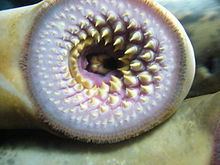
The lampreys are a very ancient lineage of vertebrates, though their exact relationship to hagfishes and jawed vertebrates is still a matter of dispute.
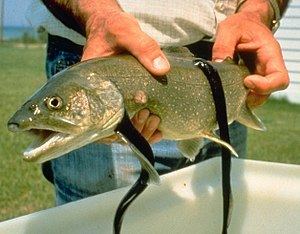
Sea lamprey panic response
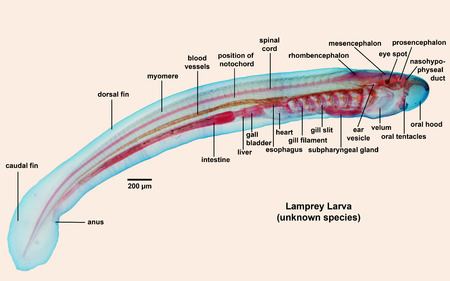
Adults superficially resemble eels in that they have scaleless, elongated bodies, and can range from 13 to 100 cm (5 to 40 inches) in length. Lacking paired fins, adult lampreys have large eyes, one nostril on the top of the head, and seven gill pores on each side of the head. The pharynx is subdivided; the ventral part forming a respiratory tube that is isolated from the mouth by a valve called the velum.
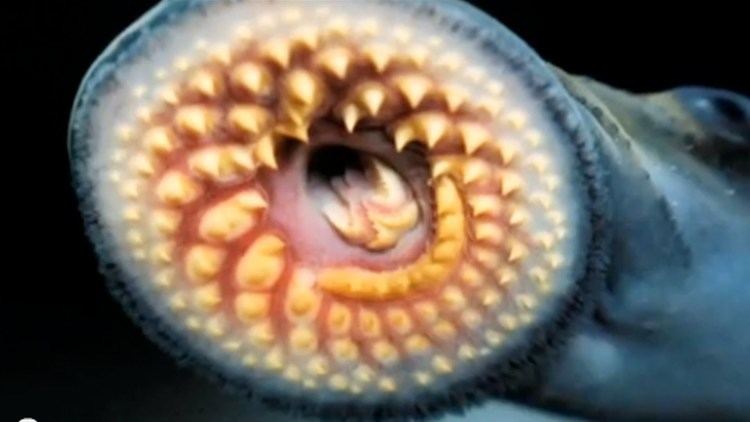
This is an adaptation to how the adults feed, by preventing the prey'S body fluids from escaping through the gills or interfering with gas exchange, which takes place by pumping water in and out of the gill pouches instead of taking it in through the mouth. Near the gills are the eyes, which are poorly developed and buried under skin in the larvae. The eyes complete their development during metamorphosis, and in adults are covered by a thin and transparent layer of skin that becomes opaque in preservatives.
The unique morphological characteristics of lampreys, such as their cartilaginous skeleton, suggest they are the sister taxon (see cladistics) of all living jawed vertebrates (gnathostomes), and are usually considered the most basal group of the Vertebrata. Instead of true vertebrae, they have a series of cartilaginous structures called arcualia arranged above the notochord. Hagfish, which resemble lampreys, have traditionally been considered the sister taxon of the true vertebrates (lampreys and gnathostomes) but DNA evidence suggests that they are in fact the sister taxon of lampreys.
Studies have shown that lampreys are amongst the most energy-efficient swimmers. Their swimming movements generate low-pressure zones around their body, which pull rather than push their bodies through the water.
Parasitic lampreys feed on prey as adults by attaching their mouthparts to the target animal's body, then using their teeth to cut through surface tissues until they reach blood and body fluid. A study of stomach content of some lampreys have also shown remains of intestines, fins and vertebrae from their prey. Although attacks on humans do occur, they will generally not attack humans unless starved. Non-parasitic lampreys, which are usually freshwater species, do not feed as adults; they live off reserves acquired as ammocoetes (larvae), which they obtain through filter feeding.
Lampreys provide valuable insight into adaptive immune systems, as they possess a convergently evolved adaptive immunity with cells that function like the T cells and B cells seen in higher vertebrates. Lamprey leukocytes express surface variable lymphocyte receptors (VLRs) generated from somatic recombination of leucine-rich repeat gene segments in a recombination activating gene-independent manner.
Northern lampreys (Petromyzontidae) have the highest number of chromosomes (164–174) among vertebrates.
Pouched lamprey (Geotria australis) larvae also have a very high tolerance for free iron in their bodies, and have well-developed biochemical systems for detoxification of the large quantities of these metal ions.
Lifecycle
Adult lampreys spawn in rivers and then die. The young larvae, ammocoetes, spend several years in the rivers, where they live burrowed in fine sediment, filter feeding on detritus and microorganisms. Then, ammocoetes undergo a metamorphosis lasting several months.
Some species do not feed after metamorphosis, while others migrate to the sea or lakes, where they feed on different species of fish and even on marine mammals. Species whose adults migrate to the sea begin preying on other fish soon after metamorphosis, even as they begin swimming downstream.
Use in research
The lamprey has been extensively studied because its relatively simple brain is thought in many respects to reflect the brain structure of early vertebrate ancestors. Beginning in the 1970s, Sten Grillner and his colleagues at the Karolinska Institute in Stockholm followed on from extensive work on the lamprey started by Carl Rovainen in the 1960's that used the lamprey as a model system to work out the fundamental principles of motor control in vertebrates starting in the spinal cord and working toward the brain.
In a series of elegant studies by Rovainen and his student James Buchanan, the cells that formed the neural circuits within the spinal cord capable of generating the rhythmic motor patterns that underlie swimming were examined. Note that there are still missing details in the network scheme despite claims by Grillner that the network is characterised (Parker 2006). Spinal cord circuits are controlled by specific locomotor areas in the brainstem and midbrain, and these areas are in turn controlled by higher brain structures, including the basal ganglia and tectum.
In a study of the lamprey tectum published in 2007, they found electrical stimulation could elicit eye movements, lateral bending movements, or swimming activity, and the type, amplitude, and direction of movement varied as a function of the location within the tectum that was stimulated. These findings were interpreted as consistent with the idea that the tectum generates goal-directed locomotion in the lamprey.
Lampreys are used as a model organism in biomedical research, where their large reticulospinal axons are used to investigate synaptic transmission. The axons of lamprey are particularly large and allow for microinjection of substances for experimental manipulation.
Distribution
Lampreys live mostly in coastal and fresh waters, although some species (e.g. Geotria australis, Petromyzon marinus, and Entosphenus tridentatus) travel significant distances in the open ocean, as evidenced by their lack of reproductive isolation between populations. Some species are found in land-locked lakes. They are found in most temperate regions except those in Africa. Their larvae (ammocoetes) have a low tolerance for high water temperatures, which may explain why they are not distributed in the tropics.
Lamprey distribution may be adversely affected by overfishing and pollution. In Britain, at the time of the Conquest, lampreys were found as far upstream in the River Thames as Petersham. Reduction of pollution in the Thames and River Wear has led to recent sightings in London and Chester-le-Street.
Distribution may also be adversely affected by dams and other construction projects disrupting migration routes, obstructing access to spawning grounds. Conversely, the construction of artificial channels has exposed new habitats for colonisation notably in North America where sea lampreys have become a significant introduced pest in the Great Lakes. Active control programs to control lampreys are undergoing modifications due to concerns of drinking water quality in some areas.
Taxonomy and systematics
Taxonomists place lampreys and hagfish in the subphylum Vertebrata of the phylum Chordata, which also includes the invertebrate subphyla Tunicata (sea-squirts) and the fish-like Cephalochordata (lancelets or Amphioxus). Recent molecular and morphological phylogenetic studies place lampreys and hagfish in the superclass Agnatha or Agnathostomata (both meaning without jaws). The other vertebrate superclass is Gnathostomata (jawed mouths) and includes the classes Chondrichthyes (sharks), Osteichthyes (bony fishes), Amphibia, Reptilia, Aves, and Mammalia.
Some researchers have classified lampreys as the sole surviving representatives of the Linnean class Cephalaspidomorphi. Cephalaspidomorpha is sometimes given as a subclass of the Cephalaspidomorphi. Fossil evidence now suggests lampreys and cephalaspids acquired their shared characters by convergent evolution. As such, many newer works, such as the fourth edition of Fishes of the World, classify lampreys in a separate group called Hyperoartia or Petromyzontida, but whether this is actually a clade is disputed. Namely, it has been proposed that the non-lamprey "Hyperoartia" are in fact closer to the jawed vertebrates.
The debate about their systematics notwithstanding, lampreys constitute a single order Petromyzontiformes. Sometimes still seen is the alternative spelling "Petromyzoniformes", based on the argument that the type genus is Petromyzon and not "Petromyzonta" or similar. Throughout most of the 20th century, both names were used pretty much indiscriminately, even by the same author in subsequent publications. In the mid-1970s, the ICZN was called upon to fix one name or the other, and after much debate had to resolve the issue by voting. Thus, in 1980, the spelling with a "T" won out, and in 1981, it became official that all higher-level taxa based on Petromyzon have to start with "Petromyzont-".
The following taxonomy is based upon the treatment by FishBase as of April 2012 with phylogeny compiled by Mikko Haaramo. Within the order are 10 living genera in three families. Two of the latter are monotypic at genus level today, and in one of them a single living species is recognized (though it may be a cryptic species complex):
Fossil record
Lamprey fossils are rare because cartilage does not fossilize as readily as bone. The first fossil lampreys were originally found in Early Carboniferous limestones, marine sediments in North America: Mayomyzon pieckoensis and Hardistiella montanensis, from the Mississippian Mazon Creek lagerstätte and the Bear Gulch limestone sequence.
In the 22 June 2006 issue of Nature, Mee-mann Chang and colleagues reported on a fossil lamprey from the Yixian Formation of Inner Mongolia. The new species, morphologically similar to Carboniferous and other forms, was given the name Mesomyzon mengae ("Meng Qingwen's Mesozoic lamprey").
The exceedingly well-preserved fossil showed a well-developed sucking oral disk, a relatively long branchial apparatus showing a branchial basket, seven gill pouches, gill arches, and even the impressions of gill filaments, and about 80 myomeres of its musculature. Unlike the North American fossils, its habitat was almost certainly fresh water.
Months later, a fossil lamprey even older than the Mazon Creek genera was reported from Witteberg Group rocks near Grahamstown, in the Eastern Cape of South Africa. This species, Priscomyzon riniensis, is very similar to lampreys found today.
As pests
Sea lampreys have become a major pest in the North American Great Lakes. It is generally believed that they gained access to the lakes via canals during the early 20th century, but this theory is controversial. They are considered an invasive species, have no natural enemies in the lakes, and prey on many species of commercial value, such as lake trout.
Lampreys are now found mostly in the streams that feed the lakes, and controlled with special barriers to prevent the upstream movement of adults, or by the application of toxicants called lampricides, which are harmless to most other aquatic species; however, those programs are complicated and expensive, and do not eradicate the lampreys from the lakes, but merely keep them in check.
New programs are being developed, including the use of chemically sterilized male lampreys in a method akin to the sterile insect technique. Finally, pheromones critical to lamprey migratory behaviour have been isolated, their chemical structures determined, and their impact on lamprey behaviour studied, in the laboratory and in the wild, and active efforts are underway to chemically source and to address regulatory considerations that might allow this strategy to proceed.
Control of sea lampreys in the Great Lakes is conducted by the U.S. Fish and Wildlife Service and the Canadian Department of Fisheries and Oceans, and is coordinated by the Great Lakes Fishery Commission. Lake Champlain, bordered by New York, Vermont, and Quebec, and New York's Finger Lakes are also home to high populations of sea lampreys that warrant control. Lake Champlain's lamprey control program is managed by the New York State Department of Environmental Conservation, the Vermont Department of Fish and Wildlife, and the U.S. Fish and Wildlife Service. New York's Finger Lakes sea lamprey control program is managed solely by the New York State Department of Environmental Conservation.
As food
Lampreys have long been used as food for humans. They were highly appreciated by ancient Romans. During the Middle Ages, they were widely eaten by the upper classes throughout Europe, especially during Lent when they were church-sanctioned food with a much meatier taste than that of most other fish. King Henry I of England is said to have died from eating "a surfeit of lampreys."
On 4 March 1953, Queen Elizabeth II's coronation pie was made by the Royal Air Force using lampreys.
In southwestern Europe (Portugal, Spain, and France) and in the northern half in Finland especially, larger lampreys are still a highly prized delicacy. Sea lamprey is the most sought-after species in Portugal and one of only two that can legally bear the commercial name "lamprey" (lampreia): the other one being Lampetra fluviatilis, the European river lamprey, both according to Portaria (Government regulation no. 587/2006, from 22 June). Overfishing has reduced their number in those parts. Lampreys are also consumed in Sweden, Finland, Russia, New Zealand, the Baltic countries, Japan, and South Korea.
The mucus and serum of several lamprey species, including the Caspian lamprey (Caspiomyzon wagneri), river lampreys (Lampetra fluviatilis and L. planeri), and sea lamprey (Petromyzon marinus), are known to be toxic, and require thorough cleaning before cooking and consumption.
In Britain, lampreys are commonly used as bait, normally as dead bait. Northern pike, perch, and chub all can be caught on lampreys. Frozen lampreys can be bought from most bait and tackle shops.
In folklore
In folklore, lampreys are called "nine-eyed eels". The name is derived from the seven external gill slits which, along with one nostril and one eye, line each side of a lamprey's head section. Likewise, the German word for lamprey is Neunauge, which means "nine-eye", and in Japanese they are called yatsume-unagi (八つ目鰻, "eight-eyed eels"), which excludes the nostrils from the count.
In literature
Vedius Pollio was punished by Augustus for attempting to feed a clumsy slave to the lampreys in his fish pond. This incident was incorporated into the plot of the 2003 novel Pompeii by Robert Harris in the incident of Ampliatus feeding a slave to his lampreys.
...one of his slaves had broken a crystal cup. Vedius ordered him to be seized and then put to death, but in an unusual way. He ordered him to be thrown to the huge lampreys which he had in his fish pond. Who would not think he did this for display? Yet it was out of cruelty. The boy slipped from the captor's hands and fled to Augustus' feet asking nothing else other than a different way to die – he did not want to be eaten. Augustus was moved by the novelty of the cruelty and ordered him to be released, all the crystal cups to be broken before his eyes, and the fish pond to be filled in... – Seneca, On Anger, III, 40Lucius Licinius Crassus was mocked by Gnaeus Domitius Ahenobarbus (cos. 54 BC) for weeping over the death of his pet lamprey:
So, when Domitius said to Crassus the orator, Did not you weep for the death of the lamprey you kept in your fish pond? – Did not you, said Crassus to him again, bury three wives without ever shedding a tear? – Plutarch, On the Intelligence of Animals, 976aThis story is also found in Aelian (Various Histories VII, 4) and Macrobius (Saturnalia III.15.3). It is included by Hugo von Hofmannsthal in the Chandos Letter:
And in my mind I compare myself from time to time with the orator Crassus, of whom it is reported that he grew so excessively enamoured of a tame lamprey – a dumb, apathetic, red-eyed fish in his ornamental pond – that it became the talk of the town; and when one day in the Senate Domitius reproached him for having shed tears over the death of this fish, attempting thereby to make him appear a fool, Crassus answered, "Thus have I done over the death of my fish as you have over the death of neither your first nor your second wife.""I know not how oft this Crassus with his lamprey enters my mind as a mirrored image of my Self, reflected across the abyss of centuries."In George R. R. Martin's novel series, A Song of Ice and Fire, Lord Wyman Manderly is mockingly called "Lord Lamprey" by his subjects in reference to his rumored affinity to lamprey pie and his striking obesity.
